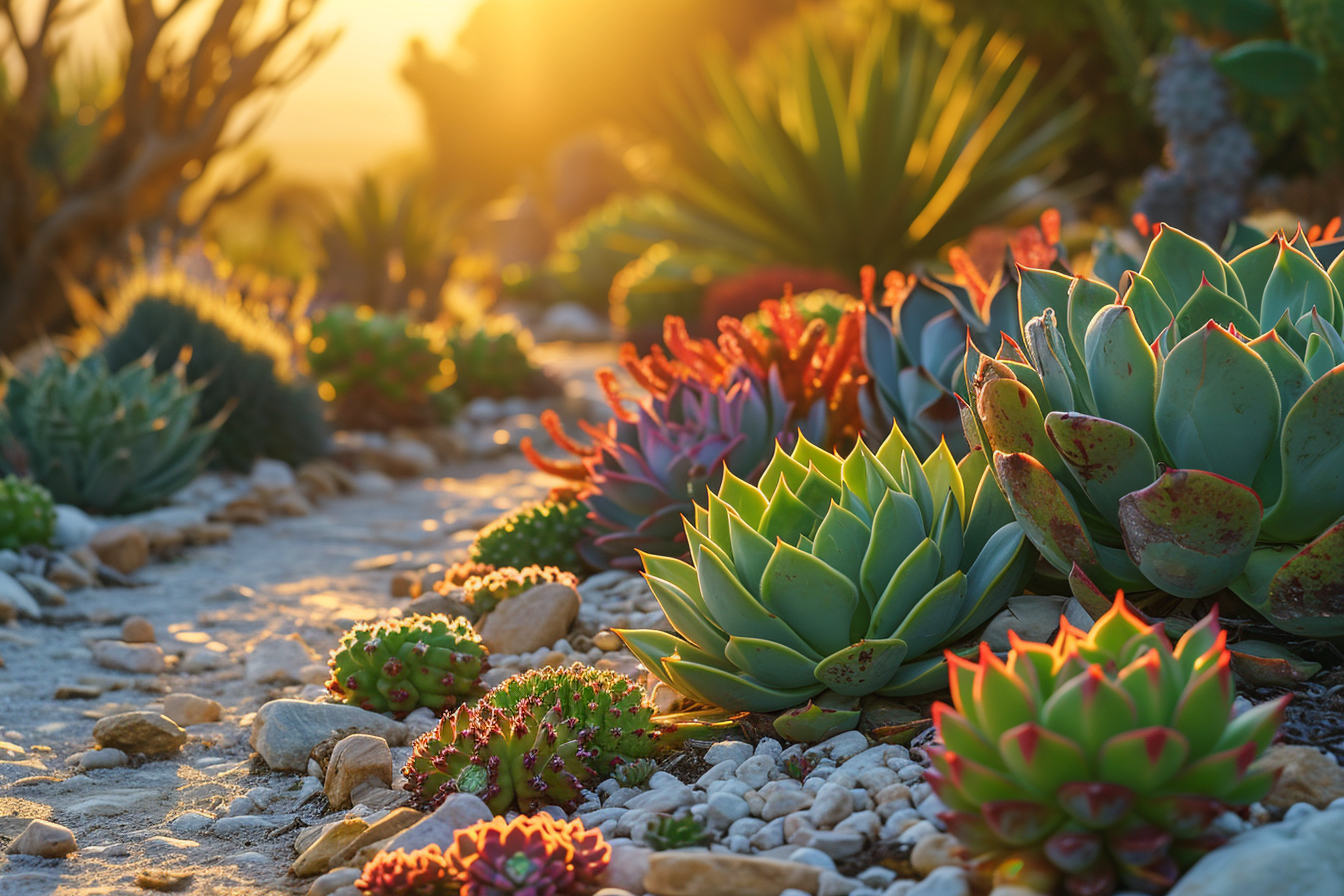Succulent gardens, often seen in Mediterranean climates, evoke a sense of coastal serenity and rugged resilience—landscapes flourishing amidst hot, dry summers and mild, wet winters. These water-wise gardens are not just environmentally sustainable in areas prone to drought but are captivating realms offering a palette of textures, colors, and varied forms.
The allure of aridity
Mediterranean landscapes are synonymous with minimalistic elegance and ease of maintenance. Designing a succulent garden in this style combines artistry with ecology, leading to spaces that are both functional and strikingly beautiful. Succulents, with their diverse adaptations to arid environments, are ideal candidates for these gardens, offering incredible variety and a sculptural aesthetic that fits perfectly within the Mediterranean ethos.
Understanding mediterranean climate and soil conditions
For a garden to flourish, one must first understand the environmental context it will inhabit. The quintessential Mediterranean climate boasts long, hot summers with little to no rainfall, coupled with cool, occasionally wet winters. The natural soil in such regions tends to be rocky or sandy—well-draining is a key characteristic, essential for succulent health.
Planning your mediterranean succulent garden
Vision and design principles
Before a single succulent is planted, envisioning the outcome is imperative. Designing a succulent garden requires considering the space available, the desired aesthetic, and how the garden will integrate with existing structures or landscapes.
Crafting contours and topography
Boldly sculpting the land can create microclimates within the garden and allow for effective water management. Elevated areas and gentle slopes encourage rainwater to reach the roots of plants efficiently yet prevent water from pooling, simulating the natural terrain of a Mediterranean landscape.
Selecting a palette of succulents
When choosing succulents, diversity in shape, color, and size is paramount. This palette should mimic the varied hues of Mediterranean landscapes, ranging from the silvery greens of olive trees to the vibrant yellows and reds of coastal wildflowers.
Ground preparation and soil amendment
The groundwork for any successful garden begins with soil preparation. Mediterranean gardens thrive in well-drained soils to mimic their natural habitats. Amending the native soil with gravel or coarse sand can enhance its drainage properties, thus providing an ideal environment for succulent roots to establish and thrive.
Creating a focal point
Every garden benefits from a focal point—an eye-catching feature that anchors the space. This could be a large, dramatic succulent, a cluster of contrasting plants, or even a piece of garden art that complements the textures and forms of the surrounding succulents.
The art of plant selection

Succulents come in an astonishing array of types, each with unique characteristics. Understanding these can turn a pleasant garden into a celebration of adaptation and survival.
Ideal succulents for mediterranean gardens
Aeoniums, Agaves, Echeverias, and Sedums are just a few examples that prosper in Mediterranean conditions. They offer not only drought resistance but a remarkable ornamental quality to the garden.
Size and growth habits
Predicting and planning for the mature size of your succulents is critical. Although most are slow-growing, some, like the agave, may eventually require a significant amount of space, impacting the garden’s composition over time.
Seasonal interest and blooming cycles
Asterisks of blossoms may appear infrequently on some succulent varieties, offering a seasonal surprise in the garden. Flowering cycles can be anticipated to ensure different plants offer visual interest throughout the year, maintaining a dynamic and ever-changing garden.
Cultivation and care
Succulents are lauded for their low-maintenance nature, but this does not mean they require no care at all. Understanding their needs is the secret to a thriving garden.
Watering strategies
Efficient watering is about mimicking natural precipitation patterns. Infrequent but deep watering encourages strong root systems and helps plants withstand dry periods, emulating the Mediterranean climate.
Strategic pruning and maintenance
Pruning not only shapes the plants but can also promote healthier growth and rejuvenation. Selective removal of leaves or branches must be performed with delicacy, maintaining the natural appearance of the succulent while encouraging it to flourish.
Pests and common issues
Vigilance against pests such as mealybugs and aphids ensures the longevity of the garden. Natural deterrents or minimal intervention can solve most issues without disrupting the delicate balance of these eco-friendly landscapes.
Integration with other flora
Succulents harmonize beautifully with other Mediterranean garden plants such as lavender, rosemary, and thyme. These companions can enhance the garden’s textural diversity while attracting beneficial pollinators, creating a more vibrant ecosystem.
Mulching and ground cover
Mulch conserves moisture, suppresses weeds, and keeps roots cool. Suitable materials include pebbles or small stones, which also complement the garden’s aesthetic. Ground cover plants, like creeping sedums, can fill in gaps and soften the appearance of the garden, acting as a living mulch.
Ecological considerations
A Mediterranean succulent garden not only offers beauty but also markers of ecological responsibility. By reducing the need for supplemental water and avoiding chemical fertilizers or pesticides, these gardens support wider efforts to sustain our environment.
Water conservation tactics
Given the increasing scarcity of water resources, employing strategies like drip irrigation or xeriscaping can drastically reduce water usage without compromising garden health or aesthetics.
Supporting local biodiversity
Choosing native or adaptive succulent species can provide a haven for local wildlife, fostering a haven for pollinators and birds, thereby reinforcing the garden’s ecological role within the broader landscape.
Advanced techniques and innovations
For the enthusiast looking to delve deeper into the art of succulent gardening, exploring advanced horticultural techniques can further enhance the garden’s allure.
Propagation and hybridization
Propagating plants from cuttings or leaves is not only cost-effective but can be immensely rewarding. Hybridizing succulents can yield new and exciting varieties, pushing the boundaries of what these resilient plants can offer.
Vertical gardens and containers
Innovation in garden design leads to creative applications such as vertical gardens and stylized containers. These expand the possibility of succulent gardening to those with limited space, such as urban balconies or compact yards.
Final reflections on crafting arid elegance

Mastering the art of Mediterranean succulent gardening is an exercise in balance—a fusion of form, functionality, and environmental stewardship. Each garden is a reflection of the individual’s vision, melded with the adaptive genius of succulents. It’s an ongoing journey of discovery, growth, and aesthetic fulfillment.
As the chosen succulents settle into their designed spaces and the ecosystem begins to flourish, the Mediterranean garden grows not just in physical form, but as a symbol of harmony between nature and human creativity. Each season offers new lessons and opportunities to refine one’s approach. The garden, though seemingly static, is in constant dialogue with the environment, adapting and evolving—a testament to the resilience and versatility of the plants that define it.
By embracing the principles and tips discussed in this exploration of succulent Mediterranean gardens, gardeners forge a connection with a tradition of landscaping that is both ancient and endlessly modern. It is a practice where patience and attention to detail yield a landscape that is not only visually arresting but also a model of sustainable beauty.
